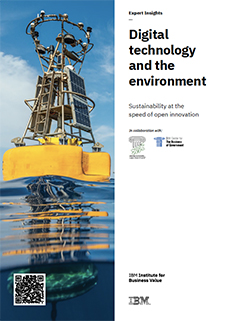
Tech and Data Innovation Can Drive Progress in Sustainability and Environmental Protection

Advanced analytics and digital technologies have great potential to help to advance environmental sustainability. The IBM Center for The Business of Government this week joined the IBM Institute for Business Value and the Environmental Law Institute in releasing a new report, Digital Technology and the Environment, which outlines this connection and provides recommendations for actions going forward. The report's authors include Daniel Esty, Yale University; Terry Yosie, former President and CEO of the World Environmental Institute; Environmental Law Institute President Scott Fulton; and IBM Vice President for Corporate Environmental Affairs and Chief Sustainability Officer Wayne Balta.
The report notes:
Our physical environment is a rich source of data. Rivers flow with it, storms swirl with it, soil teems with it. It can inform our daily lives, our interaction with the natural world, and has direct and indirect implications for our economic activity. In fact, data describing our physical environment, and the information and insight drawn from it, has underpinned all human progress.
Emerging technology paradigms can now bring this data to decisionmakers in real time, enabling responses to rapidly changing global climate conditions. These technologies include hybrid cloud computing platforms that host the broad and deep global diversity of data described above; artificial intelligence applications that enable organizations to access, understand, and act on that data more effectively; and analytics tools that drive insights for government, industry, consumer, and citizen needs.
The report addresses these challenges by drawing on insights shared in a recent expert roundtable attended by two dozen participants representing government, the private sector, academia and not-for-profit organizations from around the world. The report discusses the opportunities and challenges associated with using data to further environmental objectives, and includes recommendations for government and industry leaders to leverage new emerging technology and analytics frameworks to promote sustainability and environmental progress.
Key takeaways from the report include:
Environmental management and policy hold the potential to be an important data frontier. But the application of data and digital technologies to environmental sustainability remains limited and poorly understood among many environmental professionals and their stakeholders—including citizens.
The environmental domain poses a number of unique challenges for successfully harnessing data and digital technologies. These challenges are largely problems of policy frameworks, governance, business models, and the mobilization of capital, information and leadership, rather than technology limitations.
Data enables transparency and authenticity. By marrying digital technologies with abundant environmental data, transformative change to advance sustainability is attainable. But to succeed, it will be necessary to establish the right data governance, which, in turn, can enable open innovation.
Addressing these issues requires action. The reports recommends three primary pathways for progress.
- Focus on concrete initiatives that can generate measurable results and show value. Demonstrate the value of data for the environment to obtain more buy-in, create momentum, then scale the initiative. Tangible outcomes—more than just raising awareness—create demand, business cases, investments, and public support.
- Reinvigorate environmental protection efforts with data. Make environmental data and governance central pillars of future efforts by government agencies to support environmental sustainability—becoming more data-driven, fact-based, and empirical rather than anecdotal. Transparency and authenticity will compel action.
- Create new ways to encourage open innovation and collaboration. Include different approaches for the public, private, academic, and not-for-profit sectors to work together to accelerate innovation.
The report concludes with a set of recommended strategies for both industry and government leaders. Focusing on the public sector arena, several steps can enable significant progress for government agencies to leverage emerging technology and data protocols to drive environmental and sustainability outcomes.
1) Foster open data and open innovation as a basis for advancing the environmental sustainability agenda. This requires a fundamental shift in how to advance the environmental agenda scientifically, commercially and through public policy. Open innovation substantially alters the way governments and public sector organizations engage with each other and other stakeholders.
2) Establish international agreements on data sharing and governance, to promote innovation and collaboration within and across borders. Environmental problems tend to organize around airsheds, watersheds, and other ecosystems, which are indifferent to political boundaries. Environmental data governance as described below can be a central part of domestic and international environmental agreements.
3) Develop key data governance principles, including access-rights, data ownership and accountability, and data quality. Apply these principles to encourage the application of digital technologies as part of pre-competitive collaboration. Develop standards and best practices to counter disinformation and poor data quality.
4) Take advantage of the latest technology developments, such as hybrid-cloud computing, to provide a technology platform for open data and open innovation -- instead of relying on captive data and innovation that are restricted to those on a closed cloud platform.
5) Seek new and novel data science techniques and combinations of techniques, such as AI, to address the complexity, variety and veracity challenges of environmental data.
6) Build core competencies for data collection, analysis and management, to support regulatory, policy and collaborative frameworks that utilize digital technologies.
7) Use public procurement and funding channels to drive innovation for environmental sustainability, leading by example to work with industry partners.
8) Cultivate government leadership capable of catalyzing supporting architecture, helping to build a bridge between data generation/analysis competitors, shaping data governance systems, and adapting environmental regulation to the digital age.



